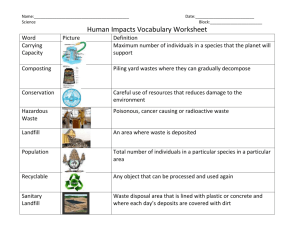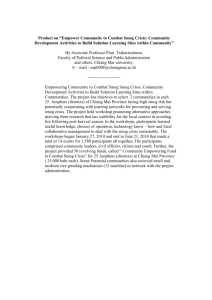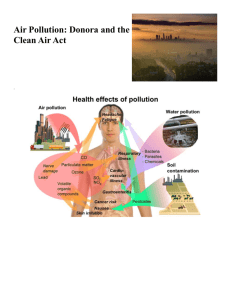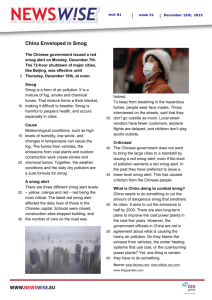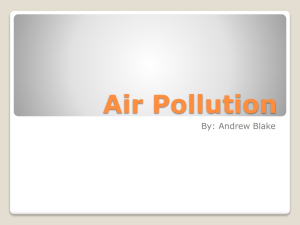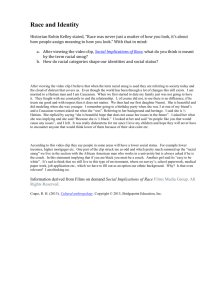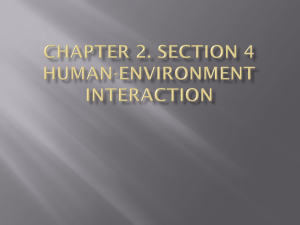Document 13134216
advertisement
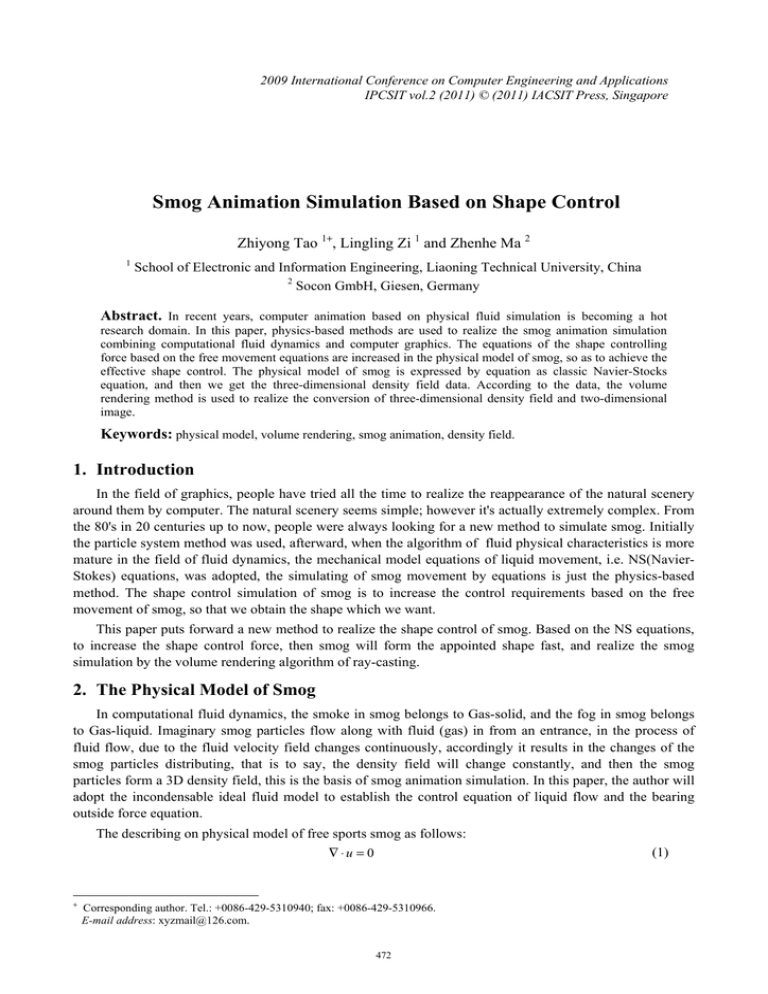
2009 International Conference on Computer Engineering and Applications IPCSIT vol.2 (2011) © (2011) IACSIT Press, Singapore Smog Animation Simulation Based on Shape Control Zhiyong Tao 1+, Lingling Zi 1 and Zhenhe Ma 2 1 School of Electronic and Information Engineering, Liaoning Technical University, China 2 Socon GmbH, Giesen, Germany Abstract. In recent years, computer animation based on physical fluid simulation is becoming a hot research domain. In this paper, physics-based methods are used to realize the smog animation simulation combining computational fluid dynamics and computer graphics. The equations of the shape controlling force based on the free movement equations are increased in the physical model of smog, so as to achieve the effective shape control. The physical model of smog is expressed by equation as classic Navier-Stocks equation, and then we get the three-dimensional density field data. According to the data, the volume rendering method is used to realize the conversion of three-dimensional density field and two-dimensional image. Keywords: physical model, volume rendering, smog animation, density field. 1. Introduction In the field of graphics, people have tried all the time to realize the reappearance of the natural scenery around them by computer. The natural scenery seems simple; however it's actually extremely complex. From the 80's in 20 centuries up to now, people were always looking for a new method to simulate smog. Initially the particle system method was used, afterward, when the algorithm of fluid physical characteristics is more mature in the field of fluid dynamics, the mechanical model equations of liquid movement, i.e. NS(NavierStokes) equations, was adopted, the simulating of smog movement by equations is just the physics-based method. The shape control simulation of smog is to increase the control requirements based on the free movement of smog, so that we obtain the shape which we want. This paper puts forward a new method to realize the shape control of smog. Based on the NS equations, to increase the shape control force, then smog will form the appointed shape fast, and realize the smog simulation by the volume rendering algorithm of ray-casting. 2. The Physical Model of Smog In computational fluid dynamics, the smoke in smog belongs to Gas-solid, and the fog in smog belongs to Gas-liquid. Imaginary smog particles flow along with fluid (gas) in from an entrance, in the process of fluid flow, due to the fluid velocity field changes continuously, accordingly it results in the changes of the smog particles distributing, that is to say, the density field will change constantly, and then the smog particles form a 3D density field, this is the basis of smog animation simulation. In this paper, the author will adopt the incondensable ideal fluid model to establish the control equation of liquid flow and the bearing outside force equation. The describing on physical model of free sports smog as follows: ∇ ⋅u = 0 + Corresponding author. Tel.: +0086-429-5310940; fax: +0086-429-5310966. E-mail address: xyzmail@126.com. 472 (1) ∂u 1 + ( u ⋅∇) u = f − ∇p ∂t ρ (2) f = -αρ z + β (T − Tamb ) z + ε h ( N × ω ) (3) ∂T = − ( u ⋅ ∇ )T ∂t (4) ∂ρ = − (u ⋅∇ )ρ ∂t (5) Assuming the fluid pressure is p ; the density is ρ , the speed is u (ux, uy, uz ) . Equation (1) and (2) are basic NS equations. The first item on the right side of (3) means the gravity of smog particles, z = (0,0,1) means perpendicular direction. Here we regard smog particles as non-quality, so the item of − αρ z is 0. The second item on the right side of (3) means the buoyancy caused by temperature difference; accordingly the third item means whirlpool binding force. α , β , ε are positive constants, Tamb is aerial environment temperature, the vorticity ω = ∇ × u , N = η / | η | , η = ∇ | ω | . Equation (4) and (5) mean that the smog density ρ and temperature T, they are regards just transportation flatly along with velocity field, so the temperature changes are replaced with density changes. In order to make smog form the assigned shape, the shape control force is increased based on equation (3), it contains two parts, i.e. the attractive force and the diffusive force. The attractive force can attract the fluid around geometric model, and make them get together around geometric model for forming the figure of the smog shape. The equation of the attractive force can be shown as follow: M fm = ρ p ∑ Φ ( Li , p ) (6) i =1 In this equation, M means edge points of geometric model, Φ(Li,p) is an attractive force coefficient vector, it is relative to distance and density; fm is the shape control force of any grid point, i.e. P withstanding. The second shape control force is the diffusive force, it makes fluid flow from the higher density region of smog to lower density region, then there will be the effect of the whole model is full of smog automatically. The vector figure of the diffusive force is shown as Figure 1; and its formula is shown as (7). In the above three equations, ∇ρ means the density grads; γ is to control the speed of smog filling the model; ui is the ideal speed; ud means the driving velocity; u* is the new speed. u ud ∇ρ u* X ui Fig. 1: The diffusive force vector figure. fd = ud Δt ud = γ (ui − u ) ui = − (7) γ ∈ [0,1] ∇ρ |u| | ∇ρ | (8) (9) 3. Solving the Physical Model Equations Step1. Based on the (3), (4), (5), (6) and (7) to compute the outside force of smog. Step2. Solving the equation of motion. Without taking into account the effects of pressure item and the convection item, to solve the (2) by using step-by-step method. 473 ∂u = f ∂t (10) Using the first-order difference scheme, we suppose the current velocity field is un0, and the new velocity field is un1, then u n1 − u n 0 = f Δt (11) By derivation of the above equation, we get (12) u n1 = u n 0 + fΔt (12) We can see that if a known velocity field and the outside force f, the new velocity field influenced by this outside force can be obtained. So when all the outside forces of smog are worked out, according to (12), the velocity field un1 can be obtained. Thereafter, considering the influences of the convection item, we can get the (13). u n1 − u n 0 = −(u n1 ⋅ Δ)u n1 Δt (13) By Semi-Lagrangian method to solve the above equation, a new velocity field un2 can be obtained. Step3. Solving the pressure, we can take the parameter ρ = 1 , by using first-order difference scheme, the derivation of ∇ ⋅ ∂u as follow: ∂t ∇⋅ ∂u u n +1 − u n ∇ ⋅ u n +1 − ∇ ⋅ u n = ∇⋅ = ∂t Δt Δt By the continuous equations, we can see ∇ ⋅ u n +1 = 0 , thus we obtain (14) ∇ ⋅ un ∇ p = ∇⋅ f + Δt 2 (14) The left side of the equation using the central difference scheme, the right side is a known quantity, the fast Fourier transform can be used to solve the pressure value. Step4. Considering the influences of pressure gradient, we may obtain the velocity field of the next moment, its calculation method is ditto, and then we can get (15). u n +1 = u n 3 = u n 2 − Δt∇ρ (15) n3 Thereby we get the new velocity field, which is the velocity field of the moment of u . Step5. According to (5), we update the density field by the velocity field. Using the Semi-Lagrangian algorithm to renew the density field, its interpolation method is still a linear Lagrange interpolation. 4. Smog Rendering The density field of smog has been obtained in above, here these massive density field data will be represented as visual image in computer which people can experience, and that is to say, we will change lifeless data into lifelike animation. In this paper, the volume rendering algorithm of ray-casting will be used, and in accordance with the density data to complete the smog animation, as shown in Figure 2. In Figure 2, we can see that start from each pixel point of the screen, according to the direction of viewpoint, to fire out a ray. This ray penetrates the density field, along the ray we can take equidistant sampling, and calculate the density of sampling points. And then synthesize the density values of sampling points in a ray, and to convert it into colour value of the pixel point, and to display pixels, finally we get on- 474 screen images of smog formation. This method is based on calculation of the density documents, so it does not compute the reflection of light and the transmission values, only needs to synthesize the density values. b A voxel of density field a Sampling points Fig. 2: The application of Ray-casting method in the density field 5. Test Results The realization of smog simulation and rendering should go through three steps in brief: setting up equations - solving equations - rendering images, through the establishment of the smog physical model, we get the equations of smog movement, and then proceed to solving the physical model, that is to say, solving equations. Rendering image is divided into two steps, firstly, rendering each frame of images, and then combining all frames to form smog animation. Here are the smog simulation results of the single static goal shape. Using VC++ and OPENGL in memory to 256MB, Windows platform, we get the smog formation process of the letters "e". The whole flow field is divided into 41*41*21 computational grid points, when smog reaches the left lower part of the letters "e"; it will automatically flow upward and fills up the whole model. This method spends user less time and is also quite convenient, the user does not need to define the complex keyframe parameters, as long as assigns his favorite geometric model as the final shape of smog, then this system can almost automatically generate the smog animation video. Fig. 3: Smog formatting letters ‘e’ 6. References [1] LiuYouquan, LiuXuehui, ZhuHongbin, Wuenhua. Physically Based Fluid Simulation in Computer Animation. Journal of computer-aided design & computer graphics 2005.12. [2] GuiKeting, WangJun, WangQiuyiing. Engineering fluid mechanics. Science press. BeiJing. 2003:2-7. [3] JiangXinghua. Hdrodynamics. Southwest Jiaotong university press. 1999:73-85. [4] R. Fedkiw, J. Stam, H. W. Jensen. Visual Simulation of Smoke [A]. Proceedings of SIGGRAPH 2001 Conference, 2001: 15-22. [5] ZhangBenzhao, YinJianan, ZhangHongji. Numerical methods in Fluids. China machine press. 2003:2-5. [6] ChenQiying, ZhuangShiyu, JinZhiyan. Implementation of the Semi Lagrangian Method in the Primitive equations Model. Meteorological Monthly.Vol24.10.20-25. [7] J. T. Kajiya, B. P. von Herzen, Ray Tracing Volume Densities, Computer Graphics SIGGRAPH 1984 Conference Proceedings, 1984, 18(3):165-174. J. Clerk Maxwell, A Treatise on Electricity and Magnetism, 3rd ed., vol. 2. Oxford: Clarendon, 1892, pp.68–73. 475
